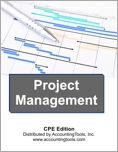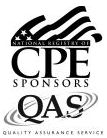Project Management (CPE Course)
CPE Credit: 14 hours
Course Type: Downloaded PDF materials with online test
Price (with PDF Textbook): $100
Course Description
Projects tend to take longer and cost more than expected. How is it possible to balance the many demands on a project manager in order to improve a project's outcome? Project Management shows how to be a successful project manager by exploring how projects are initiated, evaluated, and selected. It also addresses all phases of project planning, the use of CPM and PERT to schedule tasks, and how to make trade-offs between the various project constraints. The course tackles many other subjects as well, including change management, project estimating, risk management, reporting, and project management at the enterprise level. In short, Project Management is intended to improve the performance of a new project manager, as well as to refine the skills of a more experienced one.
Author: Steven Bragg
Course Number: BM1005
Table of Contents
Chapter 1. Overview of Project Management
Chapter 2. Project Initiation
Chapter 3. Project Selection
Chapter 4. Project Phases
Chapter 5. Project Planning
Chapter 6. Trade-off Analysis
Chapter 7. Change Control
Chapter 8. Project Close-out
Chapter 9. Project Estimating
Chapter 10. Project Risk Management
Chapter 11. Project Quality Management
Chapter 12. Project Procurement Management
Chapter 13. Project Measurement and Reporting
Chapter 14. Project Management Best Practices
Chapter 15. Enterprise Project Management
Chapter 16. Special Subjects
Chapter 17. Change Management
Chapter 18. Team Development
Chapter 19. Team Management
Learning Objectives
Recognize the characteristics of a project.
Cite the areas of responsibility for a project sponsor.
Specify the factors that impact the success rate of a project.
Specify the different ways to manage stakeholders.
Identify the reasons why feasibility studies may be needed.
Specify the reasons for conducting a gap analysis.
Recognize the uses to which a strategic alignment analysis can be put.
Recognize the different types of quantitative evaluations for projects.
Identify how a discounted payback analysis can be used.
Identify the problems with using the internal rate of return.
Specify the different elements of a net present value analysis and their effects.
Describe the different phases of a project.
Recognize the conditions under which phase overlapping occurs.
Specify the reasons for continuing an over-budget project.
Recognize the activities in a project planning and control system.
Identify the components of a work breakdown structure.
Identify the formatting of a Gantt chart.
Cite the circumstances under which a negative float can occur.
Specify the different types of project constraints.
Identify the risk involved with outsourcing project tasks.
Recognize the circumstances under which a scope change is acceptable.
Specify the types of enterprise-level constraints.
Recognize the membership of the change order committee.
Specify the contents of a change request form.
Recognize the nature of gold plating in a project.
Cite the parties involved in a project handoff.
Identify the tasks included in a project close-out.
Specify the correct way to respond to a request for a ball park estimate.
Recognize the method used to calculate a rough order of magnitude estimate.
Describe the types of risk involved in risk management.
Identify the factors comprising the risk attitude of a business.
Specify the characteristics of a high priority risk.
Recognize the different costs of quality and their characteristics.
Cite the reasoning behind using a quality audit.
Identify the criteria used to select a supplier.
Specify the circumstances under which a pre-bid conference is used.
Recognize the clauses that can be included in a contract with a supplier.
Define an employee and a contractor.
Identify the differences between a contract and a purchase order.
Recognize the calculations of variances for a project.
Recognize the circumstances under which an escalation threshold is used.
Cite the dimensions of earned value management.
Identify the different types of best practices related to project management.
Describe the reasoning behind the best practices associated with project management.
Identify the structure of a project portfolio bubble.
Specify the problems associated with only soliciting new project ideas annually.
Recognize the advantages of chunking.
Cite the different uses to which a project management office can be put.
Identify the characteristics of a minimum viable product.
Specify the key success factors for an agile project development effort.
Recognize the environment in which a task board is used.
Define the circumstances under which a company can avoid change initiatives.
Identify the means by which one can decide upon change initiatives to implement.
Recognize the circumstances under which a change initiative could fail.
Recognize the proper structuring for a successful project.
Cite the issues that can cause a team to be ineffective.
Specify the characteristics of the best team members.
Recognize the different types of communication methods.
List the characteristics of an effective project team.
Identify the different types of listening in which a person can engage.
Recognize a method for showing that a company values the contributions of its team members.
Recognize the circumstances under which the use of majority voting would work.
Cite the reasons why a consensus building initiative could fail.
Level: Overview
Instructional Method: QAS Self-Study
NASBA Category: Management Services
Prerequisites: None
Advance Preparation: None
Program Registration Requirements: Click on "Purchase Course" near the top of this page to pay for and access the course. You will then be able to download the course as a PDF file, then take an on-line examination, and then download a certificate of completion if you pass the examination.
Program Refund Policy: For more information regarding administrative policies concerning complaints, refunds, and other matters, see our policies page.
AccountingTools, Inc. is registered with the National Association of State Boards of Accountancy (NASBA) as a sponsor of continuing professional education on the National Registry of CPE Sponsors. State boards of accountancy have the final authority on the acceptance of individual courses for CPE credit. Complaints regarding registered sponsors may be submitted to the National Registry of CPE Sponsors through its website: www.nasbaregistry.org.
The NASBA sponsor identification number for Accountingtools, Inc. is 115881.
AccountingTools is an IRS Approved Continuing Education Provider. We are compliant with the requirements for continuing education providers (as described in sections 10.6 and 10.9 of the Department of Treasury’s Circular No. 230 and in other IRS guidance, forms, and instructions). Our IRS Approved Continuing Education Provider number is 72821.


